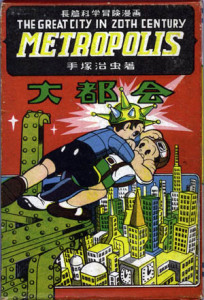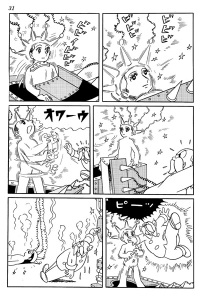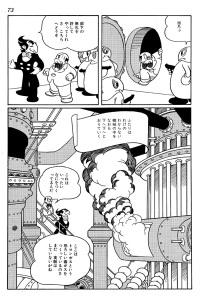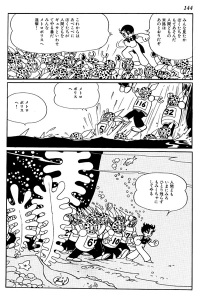Metropolis (Manga)
Also known as メトロポリス (Metoroporisu)
| English Title: | Metropolis |
| In English? | Yes |
| Japanese Title: | メトロポリス Metoroporisu |
| Type: | Book |
| Original run: | 1949/09/15 |
| Published by: | Ikuei |
| Volumes: | 1 MT-044 |
Metropolis (1949), one third of Osamu Tezuka’s early “science-fiction trilogy”, was originally published as a stand-alone, book-length adventure by Ikuei Publishing on September 15, 1949.
What it’s about
In the future year, 19XX, the International Scientists Conference is abuzz with news that the underground criminal organization, the “Red Party” has infiltrated their ranks. While the search for its leader, the nefarious Duke Red, intensifies, news breaks that major abnormal sunspot activity has appeared on the surface of the sun.
Despite the uproar, Dr. Lawton suddenly has a breakthrough in his research into the creation of artificial cells. His joy is short-lived though, as Duke Red and his thugs pay the scientist a visit and intimidate him into creating an artificial humanoid for them. However, after learning that the Red Party plans to use his creation for their own nefarious deeds, Dr. Lawton fakes the being’s destruction and escapes with it.
Although Dr. Lawton settles into a peaceful life with Mitchy, his humanoid creation, Mitchy‘s desire to see the world outside the gilded cage of Dr. Lawton‘s laboratory ends up getting him/her spotted by one of Duke Red‘s henchmen. With proof of Dr. Lawton‘s duplicity, Duke Red confronts the scientist and, when a scuffle breaks out, Dr. Lawton is killed.
Mitchy then falls into the care of a Detective Mustachio, and he/she ends up attending the same school as Mustachio‘s nephew, Kenichi. Despite the best of intentions, when Kenichi reveals Mitchy‘s status as an artificial being, he/she becomes enraged and vows revenge on the humans who would use her for their own evil purposes… inciting a robot rebellion along the way.
What you should know
A few years after the end of World War II, in an attempt to keep pace with the major publishers in Tokyo, Ikuei, an Osaka-based publisher of akahon, the low-quality, throwaway “red books”, decided to do something a bit different. They commissioned a young Osamu Tezuka for a series of full-length manga stories that were to be published with unprecedented quality – including sophisticated bindings and a duo-tone hardcover and slipcase presentation. As such, although Lost World (1948), Metropolis (1949) and Next World (1951), are not directly related plot-wise, they have come to be known, collectively, as Tezuka’s early science-fiction trilogy.
Extremely well-read, Tezuka would often find bits of inspiration here and there. After seeing a single movie still of the famous pre-war German film, Metropolis (1927) – the scene where the female robot is activated – in the film industry magazine, Cinema Quarterly [Kinema Junpou], Tezuka was drawn to the concept of artificial life. Of course he did also swipe the title, drawn to the imagery of “big time” American cities like Chicago or New York the word conjured in his young mind. This was not without precedent, as he’d done the same with the German novel The Tunnel (1913), swiping it for his original title for The Mysterious Underground Men (1948).
However, aside from the title, Tezuka’s work otherwise bears little other resemblance to it. That’s not to say Tezuka didn’t also borrow from other sources as well though. According to the afterword to the Osamu Tezuka Complete Manga Works edition (MT-044), even though much of it was cut from his final draft, he consciously tried to emulate the Thenardier’s inn scene from Les Misérables (1862) in order to evoke a certain emotional reaction to scenes involving the flower-selling girl and her sister. He also pinched the final scene where Mitchy goes up in smoke from the Hollywood feature The Invisible Ray (1936).
Also, given the short six-month production timeline, Tezuka borrowed heavily from his own previously unpublished amateur work, The Ghost Man (1945) and Old Man’s Treasure Island (1948) – elements of which would also pop up again in Age of Adventure (1951-53). What’ s more, given how well it had had the first time around, Tezuka also decided to recycle the dramatic death-bed scene ending of The Mysterious Underground Men (1948).
Despite all this, Metropolis (1949) is not simply a patchwork of bits of inspiration and plot elements sewn together. It is notable in its own right, and many of its themes, such as the rights of artificial beings and gender reversals, would show up and be explored further in works such as Astro Boy (1952-68) and Princess Knight [Shojo Club] (1953-56). In fact, sharp-eyed readers will notice that Mitchy was later deliberately cast in the role of Astro Boy’s mother.
Finally, it is also worth noting that Metropolis (1949) launched the careers of two of Tezuka’s most frequent Star System players – Duke Red and Notaarin.
Where you can get it
Luckily, for English-speaking fans, Metropolis (1949) was published by Dark Horse in 2003 as part of Tezuka’s science-fiction trilogy titles, Lost World (1948) and Next World (1951).






